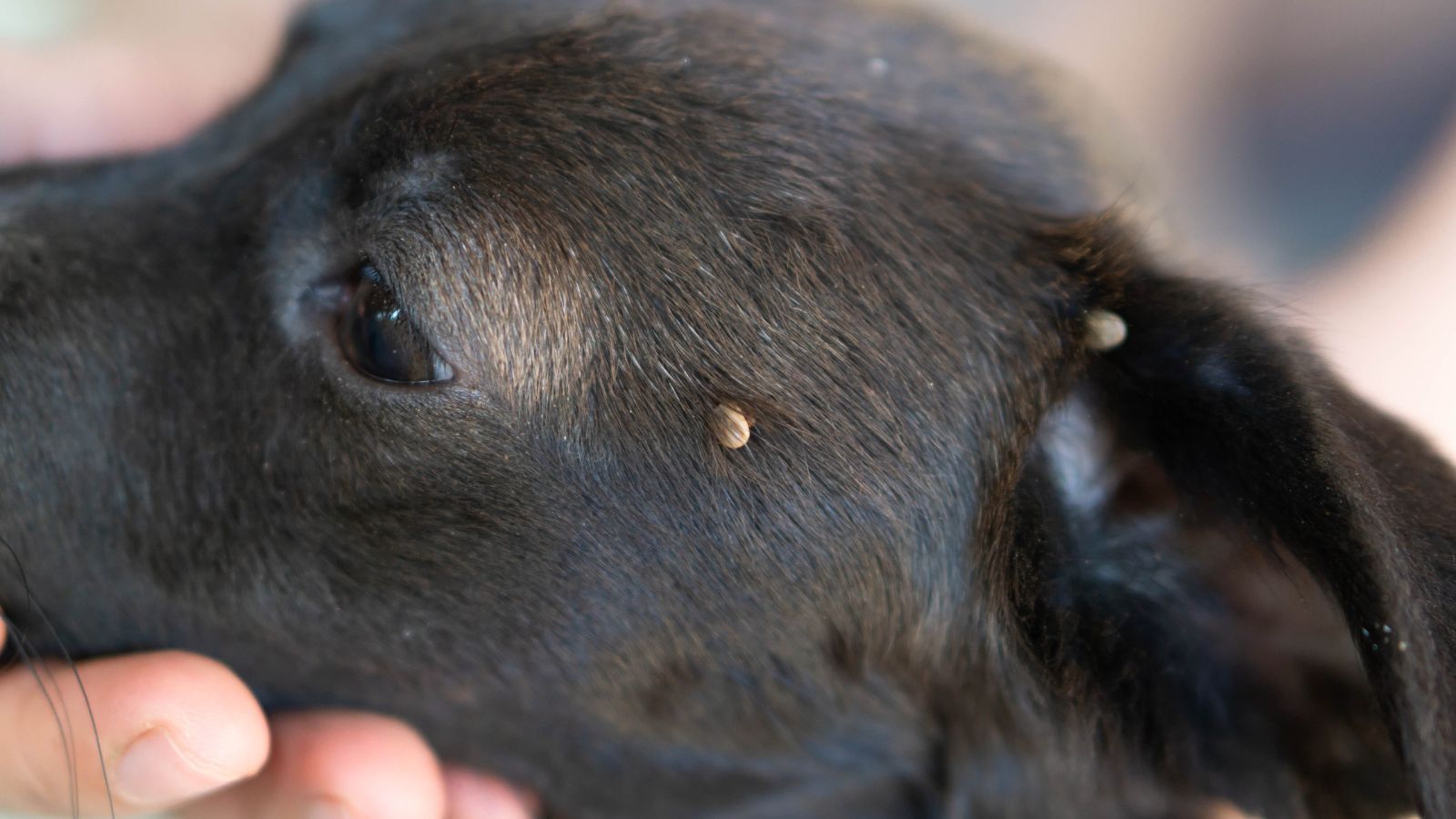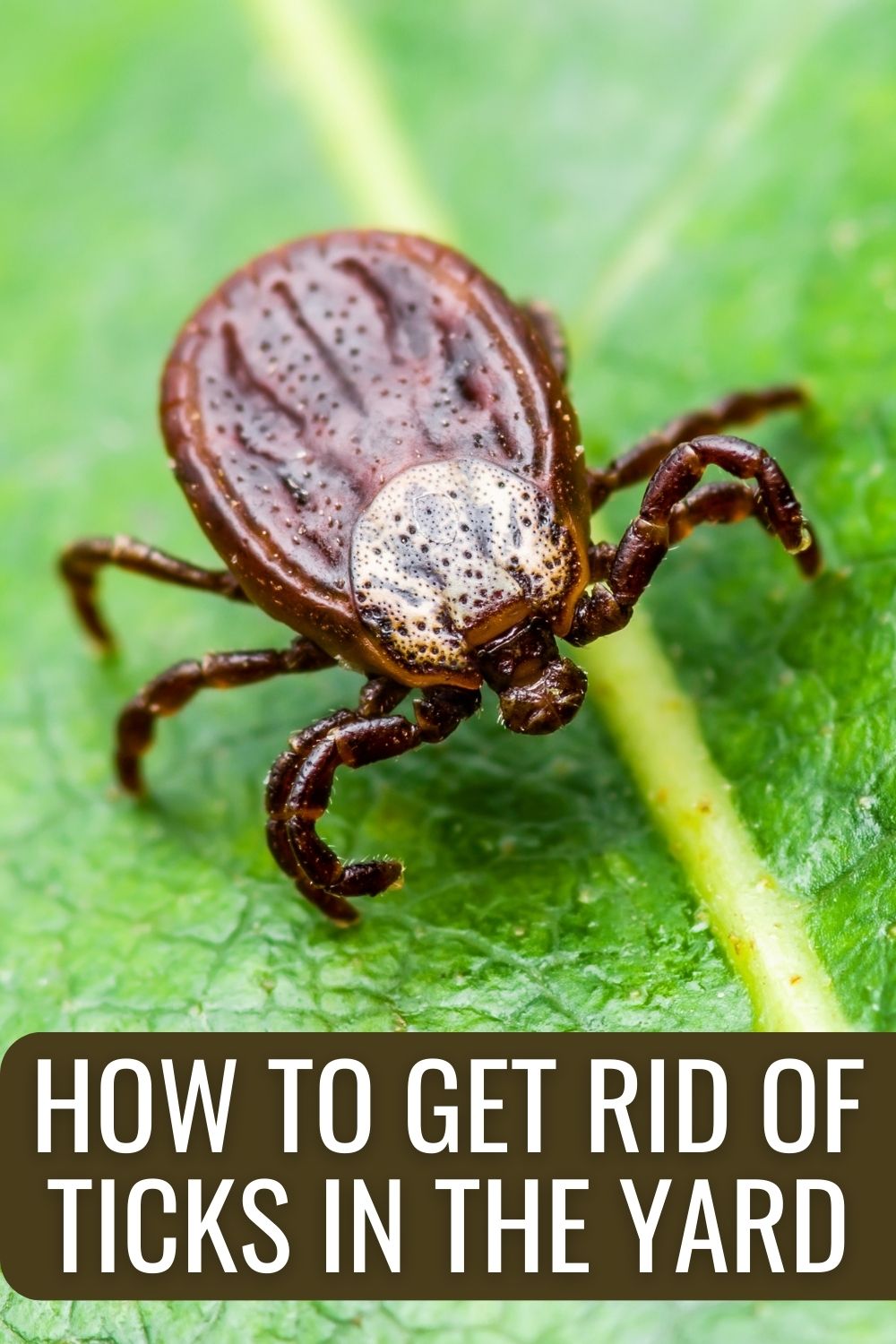There aren’t many pests that are as dangerous as ticks. Because of their ability to transmit serious diseases to humans and pets, ticks threaten your family’s well-being. Below you’ll learn how to get rid of ticks in the yard to have peace of mind throughout the summer.

While not necessarily a garden problem, ticks can keep gardeners from spending the necessary time in the garden, weeding, watering, handpicking plant pests, and enjoying the fruits of their labor.
How To Find Out If You Have Ticks in Your Backyard
You might find ticks on your pets, yourself, or a family member when it’s already too late and they are attached.
But if you want to prevent them from getting your kids and pets, get a light-colored piece of cloth (preferably a fuzzy, sticky one) and drag it through your yard. Some ticks will stick on that cloth if you have them in your yard.
How To Get Rid Of Ticks In The Yard
Here are a few tick control methods you might want to try.
Keep your grass short

Ticks love tall grasses and humid spots, so regularly mowing your grass can reduce the tick population in your backyard. Short grass doesn’t make it inviting for ticks to stick around, as there’s no place for them to hide.
Kreep away host animals and carriers

Ticks commonly hitch a ride on our animal friends, whether our cats and dogs or the wild birds we lure to our yards with feeders. If you live in a wooded area with long grasses where ticks are a problem, don’t allow your pets to roam in the woods.
Stop feeding wild birds at the end of May, when ticks become active again.
Keeping deer away from your property can reduce the deer tick population around your home. Exclude deer (one of the most popular hosts for ticks) with an 8-foot fence, or place two 4-foot fences three feet apart, as deer won’t have enough room to jump between the barriers.
You can also try your luck with deer-resistant plantings, although hungry deer will eat almost any kind of vegetation.
Establish a barrier around your property
If you live near the woods, create a dry barrier or wood chips between your yard and nearby properties because ticks love moist areas. Clear away any growth to create a three-foot wide barrier around the perimeter of your property and cover the area with a layer of gravel, mulch, or landscaping pebbles. Doing this will provide a decorative border around the yard while deterring ticks from crawling into your yard space.
If you live near a hay field, do the same to make it harder for ticks to jump into your yard.
Creating this barrier out of dry wood chips or gravel creates an unwelcoming environment for these pests. The mulch will create a hot, dry atmosphere that ticks won’t want to cross, and it will also serve as a visual reminder for your family to be extra cautious when going beyond the barrier.
Get a few guinea fowl

Guinea hens eat several hundred (some say up to 1000) ticks daily. Beware: they are loud! They’ll help keep the tick population down if you don’t mind the noise.
Other animals that eat ticks:
- Chickens (here’s a guide to raising chickens in the backyard)
- frogs
- Squirrels
- Opossums
- Guineafowl
- Wild turkeys
- Ants
Try natural tick repelling methods first
If your tick infestation is particularly severe, or you live in an area with a Lyme disease problem, a natural tick repellent and other preventative methods may not be enough.
Essential oils
But if you only have a small number of ticks, you can use a yard spray with natural essential oils on your lawn and garden, especially near shrubby areas and yard perimeters that require regular weeding.
The best natural insecticide is made of a blend of nontoxic but effective essential oils, including wintergreen, rosemary, garlic, eucalyptus, and peppermint. Although these essential oils are non-toxic, they can still cause skin and eye irritation, so follow the manufacturer’s application and dilution directions to make the tick repellant.
Beneficial nematodes
Many gardeners are familiar with using beneficial nematodes to kill garden pests like tick larvae and lawn grubs, but you may not realize that some parasitic nematodes target ticks. It’s satisfying to imagine these microscopic natural repellents feeding on the carcasses of ticks throughout the yard. Look for the nematode S. feltiae, which is commercially available and can infect as many as 100% of the common ticks it meets.
Diatomaceous earth
Diatomaceous earth’s efficacy in eliminating ticks and fleas lies in its abrasive nature, which accelerates the process of extermination. As these pests crawl over the powder, it effectively scores their hides, leading to death through dehydration.
This dust is not limited to ticks and fleas: it also proves effective against various other pests such as ants, cockroaches, slugs, grubs, bed bugs, larvae, maggots, and a multitude of others.
Use tick tubes
Tick tubes are an effective and environmentally friendly way to manage ticks in areas with a mouse population. The cardboard containers contain cotton that has been treated with active ingredients like permethrin, which are meant to be taken back to the mice nest and used by them as bedding. When this happens, any ticks living on the mice will be killed upon contact with this treated material.
Though you may find some DIY websites suggesting you make your own cardboard tubes for ticks using toilet paper rolls and cotton balls, experts advise against it. Homemade tick tubes lack control when it comes to how much permethrin is put inside and can actually end up poisoning other wildlife by accident while attempting to get rid of the ticks instead. So, it is always advised to purchase the ready-made tick tubes from a reputable source.
Use chemicals as a last resort
Mow your lawn so the grass is short for at least one day after applying the pesticide. This will help eliminate shade and areas where these tiny pests may still be trying to live. If you see more ticks once your lawn is short, apply more pesticide.
Remove dead plants, leaf piles, grass clippings, twigs, and tree branches. These are good hiding places for ticks and small animals carrying ticks, and make the perfect environment for ticks. Keep your yard tidy.
Continue checking your pets for ticks or fleas during the next two weeks, and get rid of the ticks immediately if you find any. Reapply the pesticide throughout your backyard if the problem persists after two weeks.
How to Prevent Ticks From Hitchhiking On You And Your Pets
Wear protective clothing
When you work in the yard, wear light-colored pants that you tuck into your socks. Although light-colored clothing doesn’t repel ticks and keep you safe from tick bites, you can spot tiny “seed” ticks, not much larger than a pepper flake, more easily on white pants than dark pants.
If you have long hair, pull it back and don a hat so ticks don’t race up your locks to the safety and privacy of your scalp.
Protect your pets

Ticks are often found on dogs who pick them up in a park or backyard if you have overgrown plants. You must get rid of the tick problem on your dog immediately and then control the problem in your backyard. Ticks feed on blood and commonly use animals as hosts.
The two basic types of ticks include:
- soft ticks (argasidae)
- hard ticks (ixodida)
Tick infections can spread serious tick-borne diseases, such as Lyme disease, which is why it’s crucial to eradicate the species of ticks as soon as possible.
Things You’ll Need:
- Tick shampoo
- Tick collar
- Bifenthrin pesticide
- Lawnmower
- Latex gloves
Check your pets for ticks before you treat the problem in your backyard. If you find ticks on your pet, give it a bath using shampoo to remove fleas and ticks. Also, use a collar for your dog to help eliminate any ticks your dog may come in contact with and help rid your backyard of the infestation.
Use a commercial pesticide that includes bifenthrin and can be found at your local lawn or garden stores. Ensure the pesticide label says it is specific for tick control on your lawn. Spray the pesticide all around your yard and major areas of infestation. Keep children and pets away from the treated area for at least two to three hours (or longer, as directed by the pesticide label), as contact with or ingesting pesticide can be deadly.
Warning: Always wear protective gloves, such as latex gloves, when spraying pesticides and removing diseased plants. Follow all label instructions and safety precautions for the flea and tick pet collar, as it can be toxic if eaten.



